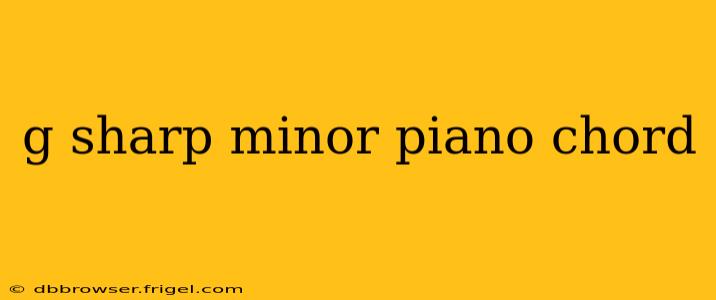The G sharp minor chord, a relatively uncommon chord in common-practice tonality, presents a unique harmonic challenge and opportunity for pianists. Its complexity lies not just in its enharmonic equivalence (A flat minor), but also in its implications within a musical context. This exploration delves into the construction, usage, and theoretical implications of this intriguing chord.
What is a G Sharp Minor Chord?
A G sharp minor chord is a minor triad built on the root note of G sharp. In its simplest form, it consists of the notes G sharp, B, and D sharp. Remember that G sharp is enharmonically equivalent to A flat, meaning it represents the same pitch. Therefore, you could also describe this chord as an A flat minor chord, which is more frequently encountered. The difference lies primarily in the context of the surrounding harmony and the key signature. Using G sharp minor implies a different tonal landscape than using A flat minor.
How to Play a G Sharp Minor Chord on Piano
Playing a G sharp minor chord on the piano is straightforward once you understand its composition. Locating the notes G sharp, B, and D sharp on the keyboard and playing them simultaneously will produce the chord. Depending on your chosen inversion, the voicing will change, allowing for melodic variations and harmonic color. Experiment with different voicings to find what sounds best within your musical piece.
What are the different inversions of a G sharp minor chord?
The G sharp minor chord, like any triad, has three inversions:
- Root position: G sharp – B – D sharp (G#, B, D#)
- First inversion: B – D sharp – G sharp (B, D#, G#)
- Second inversion: D sharp – G sharp – B (D#, G#, B)
Each inversion alters the bass note and the overall harmonic feel. The choice of inversion depends entirely on the musical context and desired effect.
What key is G sharp minor in?
This is where the enharmonic equivalence becomes crucial. While technically G sharp minor doesn't exist in a typical major/minor key system due to the absence of G sharp as a major or minor key's tonic, it functions within keys containing both G sharp and B and D#. Consider keys with a high number of sharps, such as F sharp major or D sharp major (which is enharmonically equivalent to E major). Its use would likely be chromatic – meaning outside of the primary diatonic harmony of the key.
What other chords work well with a G sharp minor chord?
The chords that complement G sharp minor depend largely on the surrounding harmonic context. However, some common choices include:
- B major: The dominant chord, creating a strong harmonic pull.
- C sharp major (D flat major): Provides a relative major feel.
- E major: Creates a subdominant feel.
- F sharp major: Offers a colorful, unexpected contrast, especially useful in modulation or chromatic movement.
How can I use G sharp minor in my music?
The most effective way to use G sharp minor is strategically within a musical context that supports its chromatic nature. You might use it as:
- A passing chord: Connecting two other chords smoothly.
- A chromatic approach: Leading to a related chord, adding a unique color.
- A part of a larger harmonic progression: Creating interesting harmonic surprises within a piece.
The G sharp minor chord is a powerful tool for those familiar with advanced music theory. Its effective usage transcends mere technical understanding and requires creative application, ensuring it becomes a meaningful component of your musical vocabulary. Through careful consideration of its implications and surrounding harmonies, the G sharp minor chord can add depth and intrigue to your piano compositions.
